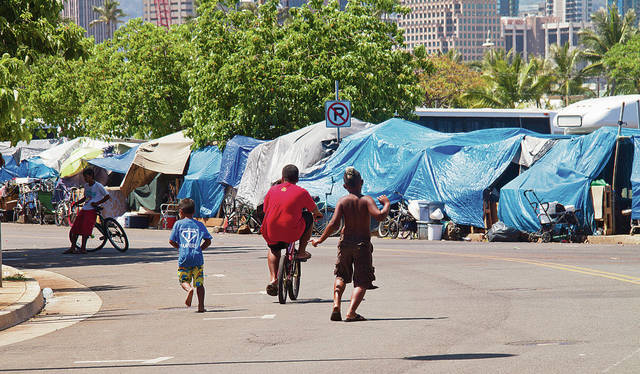Some homeless youth on Oahu forced into ‘survival sex’

DENNIS ODA / JUNE 2015
The Street Youth Study surveyed homeless people between the ages of 12 and 24 in Waikiki, downtown and homeless encampments next to the Waianae Small Boat Harbor.
Homeless youth on Oahu tend to have been abused by their parents, became homeless at the age of 14, on average, and generally live a dangerous and disturbing existence where most tried to kill themselves while others were forced to perform “survival sex,” according to the first study of its kind in four decades.
The Street Youth Study Opens in a new tabscheduled to be released today by Waikiki Health, Hale Kipa and the University of Hawaii Center on the Family reinforced some anecdotal evidence while revealing some surprises, such as the average age when young people first became homeless: 14.
“We knew it was young, but to actually get the data to affirm it, was ‘Wow, this is a real issue,’” said Kent Anderson, Waikiki Health’s chief high-risk services officer, who oversees youth outreach.
The study Opens in a new tab also exploded the myth that homeless youth “are just a bunch of kids looking for trouble,” Anderson said. “In fact, it’s kids who are victims of abuse who are making rational decisions to find a safer environment.”
>> Nearly half — 48 percent — experienced homelessness the first time with their families.
>> Forty percent had been in foster care.
Don't miss out on what's happening!
Stay in touch with breaking news, as it happens, conveniently in your email inbox. It's FREE!
>> Forty-eight percent had been in juvenile detention.
>> Fifty percent had parents with substance abuse problems.
>> Sixty-one percent had parents who had been incarcerated.
>> Seventy-seven and a half percent had been emotionally, physically or sexually abused.
While on the streets:
>> 13 percent participated in “survival sex,” meaning they had sex in exchange for money, food, drugs or a place to stay.
>> 65 percent of those who participated in survival sex said they were “forced” to perform sex acts.
“They don’t identify it as prostitution,” said Alika Campbell, program coordinator for Hale Kipa. “‘Survival sex’ is, ‘I need a place to stay so I’ll hook up with somebody.’”
>> 29 percent had children of their own.
>> 32 percent performed “self-harming acts” and 58 percent attempted suicide.
>> 32.5 percent said they have been diagnosed with a mental illness.
>> 38 percent have been beaten or physically attacked while homeless.
The study surveyed 151 homeless people between the ages of 12 and 24 in Waikiki, downtown and at the homeless encampment next to the Waianae Small Boat Harbor between July and October 2016.
It shows that the majority of Oahu’s young homeless (56 percent) were born in the islands, despite a persistent belief that Hawaii’s homeless problem is driven by malihini.
“There’s always the perception that there’s an influx of homeless people moving to Hawaii,” said Ivette Rodriguez Stern, a junior specialist with UH’s Center on the Family. “These are our kids.”
They’re overwhelmingly male (59 percent), and the plurality (44 percent) are Hawaiian or part-Hawaiian, followed by “Other/two or more races (not including Hawaiian)” (18 percent), Pacific Islander (15 percent), Caucasian (11 percent), Asian (6 percent) and black (6 percent).
The study also found that 30 percent of Oahu’s young homeless were born in a U.S. state other than Hawaii, and 22.5 percent were from military families, as well as 9 percent who came from the Federated States of Micronesia.
Anderson, who was raised in an Air Force family, said, “I did not realize there was such a connection between street youth and military families.”
Unlike Hawaii’s adult and family homeless population, there are no shelters specifically for unaccompanied homeless people under the age of 18 because of complex legal and liability issues involving guardianship and parental rights.
So the 400 to 600 young homeless people who visit Waikiki Health’s Youth Outreach drop-in center in Waikiki each year are on their own after the doors close at 6 p.m.
“We welcome everyone,” Campbell said Thursday at the center. “After 6 you don’t have to go home, but you can’t stay here. At the end of the day, you’re headed out wherever you’re going.”
The Street Youth Study was designed to update the last look at Oahu’s homeless youth, which was conducted in the 1980s as a prelude to the opening of the Youth Outreach drop-in center in 1989.
“This is an issue that no one was really talking about just a few years ago,” Anderson said. “It’s really been under the radar. We’re hoping that we, as a community, gain a much deeper understanding of what factors contribute to youth getting on the streets, what issues youth face and what can help get youth off of the streets.”





